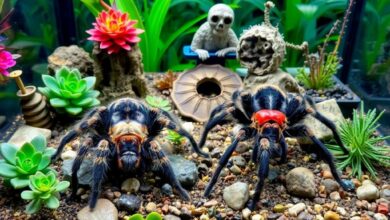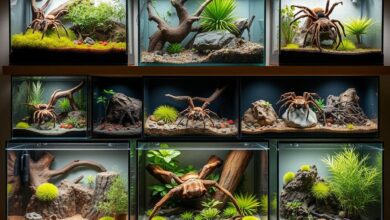Special considerations for designing terrariums for arboreal tarantulas

Arboreal tarantulas are fascinating, but setting up their terrariums needs extra care. They love vertical spaces for climbing and hiding. So, the terrarium’s size, substrate, heating, lighting, and humidity control are all key to a happy home for these spiders.
These tarantulas love to climb and explore, so their terrariums should let them do just that. The terrarium should have lots of places to perch, hide, and move around. Adding things like branches, cork bark, and fake plants makes it feel more like their natural home.
Keeping the right environment is vital for arboreal tarantulas. You need to watch and adjust the temperature, lighting, and humidity to fit their needs. Adding live plants and a special substrate can make the terrarium feel more natural and self-sustaining.
Introduction to Arboreal Tarantula Habitats
Arboreal tarantulas live in tropical and subtropical areas. They are well-suited for life in trees, bushes, and other plants. These spiders have special skills like climbing, making webs, and digging burrows. These skills are important in their homes.
Understanding Arboreal Tarantula Behavior
Arboreal tarantulas have amazing skills for living in trees and bushes. They climb well, thanks to strong legs and special adaptations. They also make complex webs for hunting, resting, and keeping their babies safe.
Environmental Conditions for Arboreal Species
It’s key to keep the right temperature, humidity, and air flow for arboreal tarantulas in captivity. Keeping an eye on these factors is vital for a happy home for your arboreal tarantula.
| Environmental Factor | Recommended Range |
|---|---|
| Temperature | 75-85°F |
| Humidity | 60-80% |
| Air Circulation | Moderate to high |
Knowing what arboreal tarantulas need is key to making great terrariums for arboreal species. This lets them live well in captivity.

Terrarium Size and Dimensions
When setting up a terrarium for an arboreal tarantula, the size matters a lot. These spiders need lots of vertical space for climbing, web-building, and behaving naturally. A terrarium should be at least 12 inches tall for most arboreal tarantulas.
Vertical Space Requirements
Arboreal tarantulas love to climb and spend a lot of time up high. They need enough vertical space to spin webs and move around. The terrarium should be tall enough for the spider to explore and feel at home.
Floor Space Considerations
The floor space in the terrarium is also key. It should fit the adult size of the tarantula and let it move easily. If you have more than one tarantula, they’ll need more space to live together peacefully.
| Tarantula Species | Adult Size | Minimum Terrarium Size |
|---|---|---|
| Avicularia avicularia (Guyana Pinktoe) | 4-5 inches | 12″ x 12″ x 18″ |
| Poecilotheria metallica (Metallic Baboon) | 6-8 inches | 18″ x 18″ x 24″ |
| Psalmopoeus irminia (Venezuelan Suntiger) | 5-7 inches | 15″ x 15″ x 24″ |

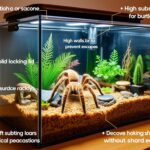 How to ensure that the terrarium is safe and prevents tarantula escapes
How to ensure that the terrarium is safe and prevents tarantula escapes
Bioactive Terrariums for Arboreal Species
Creating a bioactive terrarium is a great way to give your arboreal tarantulas a more natural home. These setups have a living ecosystem with beneficial microorganisms and invertebrates. They help keep the substrate clean and break down waste. With the right plants, decor, and substrate, you can make a thriving home for your arboreal tarantulas.
Bioactive terrariums for arboreal tarantulas copy their natural habitats. They have live plants, leaf litter, and decomposers like springtails and isopods. This setup keeps the substrate stable and full of nutrients. It means less need for changing the substrate and a more natural, easy-care habitat.
When making a bioactive terrarium for arboreal tarantulas, think about what your tarantula needs. You must balance humidity, ventilation, and vertical space for their health. A self-sustaining, natural environment lets your arboreal tarantula live its best life.
| Bioactive Terrarium Components | Benefits |
|---|---|
| Live Tropical Plants | Improve air quality, provide hiding spots, and contribute to the natural ecosystem |
| Nutrient-Rich Substrate | Support a diverse community of decomposers, maintain moisture and humidity levels |
| Cleanup Crew (Springtails, Isopods) | Naturally break down organic waste and maintain a healthy, balanced environment |
| Natural Decor (Branches, Rocks, Logs) | Provide hiding spots, climbing opportunities, and a more naturalistic aesthetic |
Adding these elements to your arboreal tarantula’s home makes a self-sustaining, beautiful, and enriching space. It meets the needs of your Bioactive Terrariums and Terrariums for Arboreal Species.
Naturalistic Terrarium Setup
Creating a naturalistic terrarium setup is key for arboreal tarantulas. It means picking the right substrates and adding tropical plants. This makes the enclosure look good and work well for the tarantulas.
Terrarium Substrates
The substrate is vital for keeping the right moisture and drainage for arboreal tarantulas. A mix of organic topsoil, coconut coir, and sand works well. Adding sphagnum moss helps keep humidity up. For tarantulas that like to dig, reptile bark or aspen bedding can be added for hiding and burrowing.
Tropical Terrarium Plants
Adding live tropical plants makes the terrarium look more natural and gives tarantulas more places to climb. Snake plants, pothos, and small ferns are great choices because they like the humid terrarium environment. Make sure the plants are safe for your tarantula species.
Choosing the right substrates and plants makes a terrarium setup that looks good and meets your tarantula’s needs. This setup is perfect for arboreal tarantulas.
Terrariums for Arboreal Species
Creating the perfect terrarium for arboreal tarantulas is key for their health. These enclosures need vertical space, climbing spots, hiding places, and the right environment. By focusing on size, substrate, décor, and climate control, you can make a great home for your climbing arachnid.
For arboreal tarantulas, make sure the terrarium has enough vertical space. These spiders love to climb and explore. Use natural branches, cork bark, and other sturdy items for them to climb on. Set up the décor to encourage web-building and molting.
- Provide a deep substrate layer, at least 4-6 inches, to allow the tarantula to burrow and hide as needed.
- Choose a substrate that retains moisture and maintains the appropriate humidity levels, such as coconut fiber or sphagnum moss.
- Include hiding spots, such as cork bark tubes or artificial foliage, to give the tarantula a sense of security and a place to retreat.
- Carefully monitor the temperature and humidity levels in the terrarium, ensuring they align with the specific requirements of the arboreal species.
| Arboreal Tarantula Species | Ideal Terrarium Size | Substrate Depth | Humidity Range | Temperature Range |
|---|---|---|---|---|
| Poecilotheria (Ornamental Tree Spiders) | 18″ x 18″ x 24″ | 4-6 inches | 70-80% | 75-85°F |
| Psalmopoeus (Pinktoe Tarantulas) | 12″ x 12″ x 18″ | 4-6 inches | 65-75% | 70-80°F |
| Avicularia (Pinktoe and Curly-Hair Tarantulas) | 12″ x 12″ x 18″ | 4-6 inches | 70-80% | 75-85°F |
By understanding the needs of arboreal tarantulas and designing a great terrarium, you can give them a safe and happy home. The right mix of vertical space, hiding spots, and environmental controls is key. This ensures the long-term health and happiness of your arboreal tarantula.
Arboreal Reptile Enclosures
Creating homes for arboreal reptiles is similar to setting up for arboreal tarantulas. Snakes like the vine snake or the green tree python need lots of vertical space and places to climb. Lizards, such as the crested gecko or the green anole, do well in terrariums with lots of plants and structure.
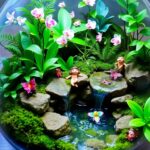 Ideas and examples of themed terrariums inspired by specific natural habitats
Ideas and examples of themed terrariums inspired by specific natural habitats
Arboreal Snake Habitats
For Arboreal Snake Habitats, you need a tall enclosure with strong branches and vines. These help the snakes climb and perch, just like in the wild. Adding hiding spots and thick foliage makes the space safe and interesting for them.
Arboreal Lizard Terrarium
For arboreal lizards, focus on a terrarium that looks like their natural home. The crested gecko, for instance, is about 20 cm long, including its tail. The ideal temperature is 26-28°C in the warm area, 20-22°C in the cool area, and 24-26°C overall.
Keeping humidity at 50%, with times of 70-80% during misting, is key. This helps them stay healthy.
Arboreal lizards, like the crested gecko, need a terrarium full of plants, branches, and places to hide. They eat insects like crickets, dubia roaches, Red Runner roaches, and grasshoppers, given 2-3 times a week. Knowing what they need helps you make a great home for them.
Tropical Terrarium Design
Creating a Tropical Terrarium is a great way to make a home for arboreal tarantulas and other climbing spiders. Use tropical plants, natural decorations, and the right substrate and humidity to mimic their natural habitats. It’s important to keep an eye on the temperature and lighting needs of these tropical species for a healthy and beautiful terrarium.
Here are some key elements to consider for a tropical terrarium:
- Tropical Plants: Pick a mix of vibrant plants that look like those in tropical rainforests. Think about using ferns, bromeliads, philodendrons, and other plants that love humidity.
- Natural Décor: Add things like driftwood, vines, and rocks to give your terrarium depth and texture. These also make great hiding spots for your tarantula.
- Appropriate Substrate: Choose a substrate that holds moisture and nutrients well. A blend of sphagnum moss, coconut fiber, and sand works great.
- Humidity and Misting: Keep humidity levels high, between 70-90%, by misting the terrarium often. This makes a comfy home for your tropical pets.
- Lighting and Temperature: Make sure the lighting and temperature are right, usually between 75-85°F, to mimic a tropical climate.
With careful planning, you can make a tropical terrarium that’s both beautiful and a great place for your arboreal tarantulas and other climbing species to live.
| Paludarium Element | Description |
|---|---|
| Canopy | The top area of the paludarium, often featuring lush, tropical plants. |
| Land | The terrestrial features, including substrate, rocks, and driftwood. |
| Water | The aquatic portion, which can include a pond, stream, or waterfall. |
Terrarium Misting Systems
Keeping the right humidity is key for arboreal tarantulas’ health. Using a terrarium misting system or an automatic misting device helps keep humidity high. These spiders need a humid place to live well.
Humidity Control for Arboreal Tarantulas
It’s important to watch and adjust the terrarium’s humidity for arboreal tarantulas. Adding a humid hide, a spot with more moisture, helps these spiders stay happy. By managing the terrarium’s humidity, you help your arboreal tarantula stay healthy and happy.
| Terrarium Misting Systems | Humidity Control for Arboreal Tarantulas |
|---|---|
|
|
Using a good terrarium misting system and controlling humidity helps your arboreal tarantulas thrive. This care ensures your spiders live their best lives in a well-kept home.
Heating and Lighting Requirements
Arboreal tarantulas need outside heat to keep their body temperature right. They need a warm spot and a cooler area to live healthy lives. Some also need low-level UVB lighting for their bones to stay strong. Keeping the terrarium’s temperature and lighting just right is key for your tarantulas.
For heating, make sure there’s a warm spot and a cooler area in the terrarium. This lets the tarantula control its body temperature. The warm spot should be between 23-32°C (73-90°F), depending on the species.
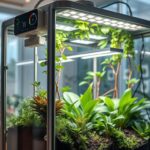 How to automate temperature, humidity and light control in your terrarium
How to automate temperature, humidity and light control in your terrarium
Some arboreal tarantulas also need low-level UVB lighting. This helps them make vitamin D3, which is important for strong bones. But, make sure to check what your tarantulas need to avoid any problems.


